Biblical vessels, from the Ark of the Covenant to humble clay jars, hold profound meanings that echo through time—discover their secrets within.

Types of Vessels in the Bible
You might think discussing vessels from the Bible seems antiquated, yet these artifacts hold layers of meaning that resonate even today. From the Ark of the Covenant, symbolizing the divine presence, to humble clay jars embodying our fragility, each vessel carries a narrative that's as rich in symbolism as it is in history.
Consider the Golden Lampstand, or Menorah, not just a source of light but a beacon of wisdom and enlightenment. As we explore these vessels, you'll find their relevance extends beyond biblical times, offering insights into our modern lives. Why do these ancient objects still capture our imagination? Let's find out together.
Key Takeaways
- The Ark of the Covenant symbolizes God's divine presence and the covenant with the Israelites.
- Golden Lampstands represent divine guidance through their symbolic light and purity.
- Clay Jars and Pottery metaphorically teach about human frailty and the potential for divine transformation.
- Bronze Basins and Silver Trumpets were essential in ritual purification and communication, underscoring the importance of purity and divine connection.
The Ark of the Covenant
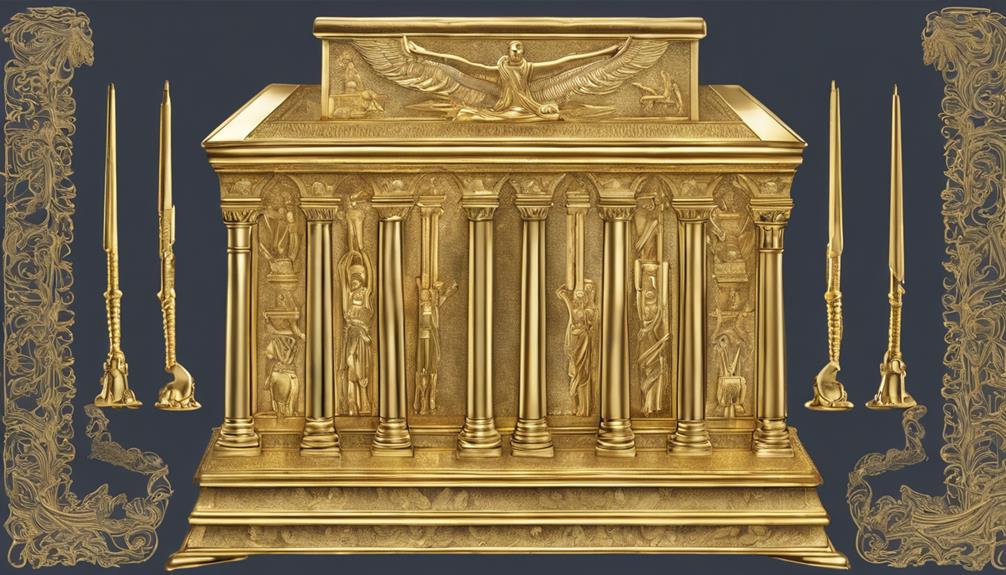
Among the myriad sacred vessels mentioned in the Bible, the Ark of the Covenant stands out as a symbol of divine presence and a testament to the covenant between God and the Israelites. Crafted according to divine instructions, this ornate chest held sacred objects, including the tablets of the Ten Commandments, a jar of manna, and Aaron's rod. Its construction, detailed in the Book of Exodus, followed specific guidelines provided by God, underscoring its significance and the sacredness of its contents.
The Ark's role went beyond being a mere container; it was central to the Israelites' religious life, serving as the physical manifestation of God's presence among His people. Whenever the Ark was carried into battle, it symbolized God's support and protection, reinforcing its importance not just as a religious artifact but also as a symbol of divine guidance and assurance.
The covenant significance of the Ark can't be overstated. It was a tangible reminder of the agreement between God and the Israelites, a constant representation of divine law and guidance. Its presence in the Tabernacle, and later the Temple in Jerusalem, was a focal point for worship and a perpetual reminder of God's promise to His people.
Clay Jars and Pottery
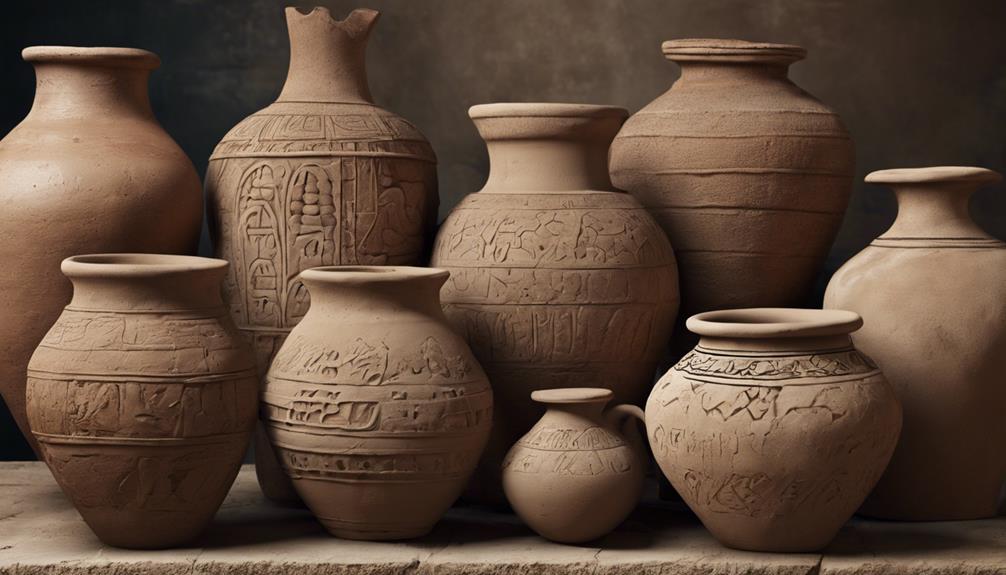
In the biblical narrative, clay jars and pottery serve not only as everyday items but also embody deeper spiritual and symbolic meanings. You'll find that pottery symbolism is rich, often representing the frailty and the malleability of human life in the hands of the divine. Just as a potter shapes clay into a vessel, so too, the biblical texts suggest, does God shape individuals and nations according to His will.
The quality of the clay plays a significant role in this symbolism. Fine, pure clay results in strong, useful vessels, while impure clay can lead to flawed pottery that's easily broken. This distinction mirrors the biblical teachings on purity, integrity, and the consequences of moral failings. The process of refining, shaping, and firing the clay into pottery is paralleled with spiritual refinement through trials and tribulations.
Moreover, clay jars are often used metaphorically to highlight the contrast between earthly fragility and the treasure of spiritual truth they contain. This imagery underlines the theme of humility and the value of inner spiritual wealth over external appearances. Through such symbolism, clay jars and pottery in the Bible teach profound lessons about purpose, transformation, and divine craftsmanship.
The Golden Lampstand
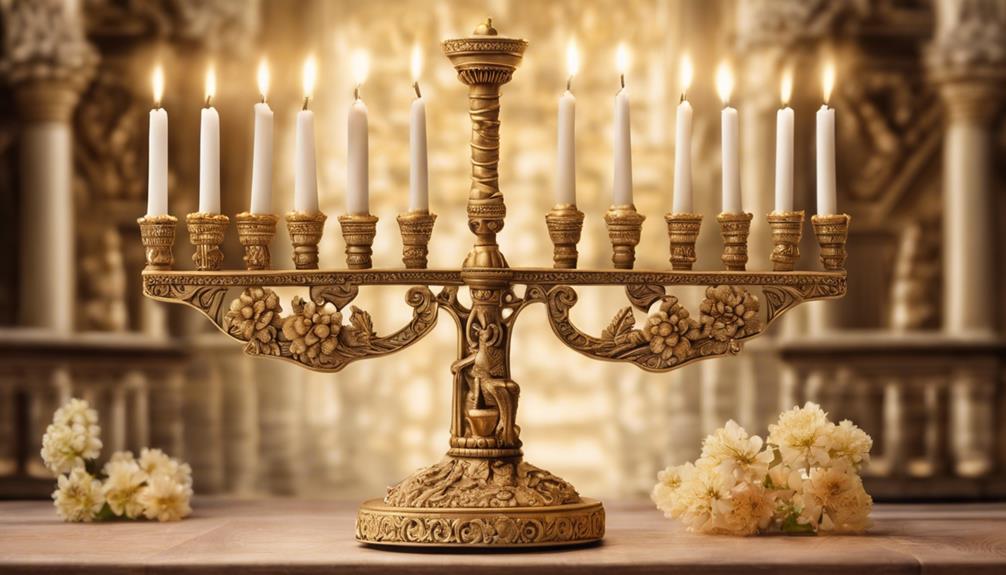
Delving into the symbolism of the Golden Lampstand, it's crucial to understand its representation of divine light and guidance in the tabernacle, illuminating the path for believers. This artifact, described in detail in the Bible, not only served a functional purpose but also held profound symbolic meanings, deeply intertwining with the spiritual fabric of the faith. Its design and construction, a testament to divine instructions, showcase advanced craftsmanship techniques of the time.
- Divine Illumination: Represents God's presence and guidance, a light in the spiritual darkness.
- Seven Branches: Symbolize perfection and completeness, with each branch possibly representing a day of creation or aspects of God's spirit.
- Pure Gold Material: Signifies purity, divinity, and the unblemished nature of God.
- Almond Blossoms: The decorations mimic almond blossoms, symbolizing watchfulness and the promise of renewal.
- Position in the Tabernacle: Strategically placed to light up the table of showbread and the altar of incense, pointing to its role in enlightening the sacred offerings to God.
Understanding the Golden Lampstand's symbolic meanings and the craftsmanship techniques employed in its creation deepens the appreciation for its significance in biblical teachings, serving as a reminder of the omnipresent guidance and purity of God's light.
Bronze Basins
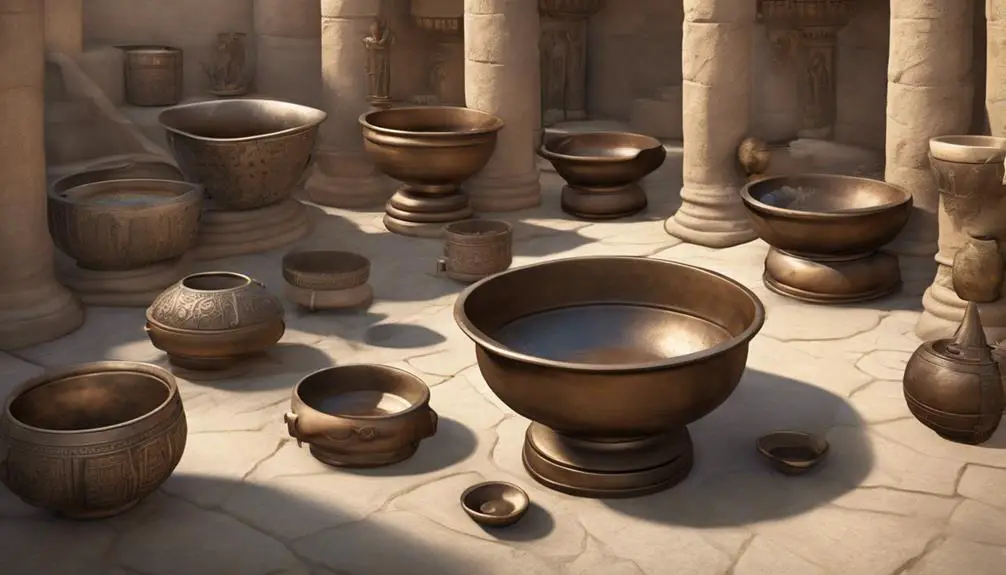
Transitioning from the spiritual illumination symbolized by the Golden Lampstand, let's explore the Bronze Basins, which played a critical role in the purification rituals of ancient biblical times. These basins, crafted with meticulous attention to detail, showcase the advanced craftsmanship techniques of the era. Artisans employed specific methods to mold and shape bronze into functional yet symbolic vessels, integral for the rituals performed by the priests.
The ritual significance of Bronze Basins can't be overstated. These weren't mere containers but pivotal elements in the ceremonial cleanliness required before approaching the sacred. According to biblical texts, priests used these basins for washing their hands and feet, symbolizing the purification of the body and spirit before performing their holy duties. This act underscored the importance of purity, reflecting a deeper, spiritual cleanliness sought in the presence of the divine.
Understanding the dual significance of these basins—both as feats of craftsmanship and as essential components in ritual purification—offers insights into the profound ways material culture and spiritual practice were intertwined in biblical times. The Bronze Basins thus stand as a testament to the intricate relationship between art, ritual, and religion in the ancient world.
The Silver Trumpets
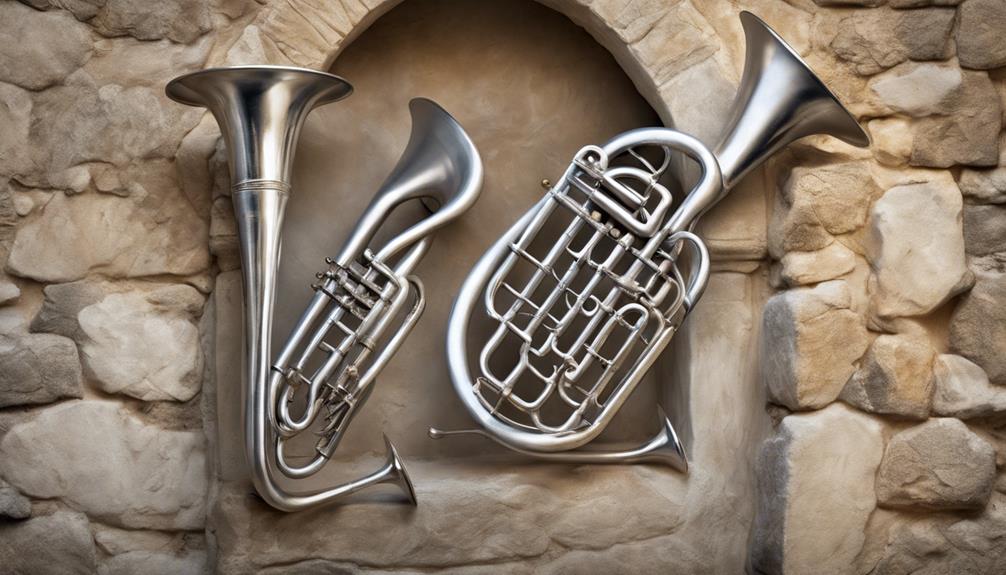
Shifting our focus from the Bronze Basins, integral for purification, we now explore the Silver Trumpets, whose sounds held profound significance in the rituals and communications of biblical times. The construction and ceremonial usage of these trumpets aren't merely footnotes in history; they're essential components of the fabric that weaves together the practices and beliefs of the era.
- Trumpet Construction: Crafted from pure silver, these instruments were designed with meticulous care, reflecting their importance.
- Ceremonial Usage: Used in various ceremonies, their blasts could signify the beginning of festivals, the gathering of the assembly, or the coordination of movements during travel.
- Signals for War: In times of conflict, the trumpets served as signals, calling for the assembly of troops or announcing the onset of an attack.
- Communication Means: Beyond their ceremonial use, they were a key method of communication across distances, transcending the limitations of the spoken word.
- Sacred Association: Their sound wasn't just a call to action but also a signal of divine presence, intertwining spiritual significance with practical uses.
Understanding the construction and ceremonial usage of the Silver Trumpets offers insight into their pivotal role in biblical history, bridging the gap between the divine and the earthly.
Frequently Asked Questions
How Were Vessels Used in Daily Life Outside of Religious Rituals in Biblical Times?
In biblical times, vessels weren't just for religious rituals; they were essential in daily life too. You'd find a variety of kitchen utensils made from clay, metal, or wood. These weren't just for cooking but also for serving and storage.
Water storage was another critical use, as vessels held water for drinking, cooking, and cleaning. Their design and material varied, reflecting their everyday utility in homes across ancient societies.
What Is the Significance of the Materials Used (E.G., Clay, Bronze, Gold) in the Creation of These Vessels in the Context of Biblical Narratives?
In the narratives you're exploring, the materials like clay, bronze, and gold aren't just about utility. They carry deep meanings. Clay's fragility mirrors human vulnerability, while bronze and gold's durability symbolize divine strength and purity.
It's not just about crafting vessels; it's an artistic expression of beliefs and values. This choice of materials goes beyond practicality; it's steeped in symbolism, reflecting broader themes of human experience and divine attributes.
Are There Any Vessels Mentioned in the Bible That Are Believed to Have Supernatural Properties or Powers?
You might wonder if any vessels mentioned in historical texts are believed to possess supernatural properties. Indeed, certain artifacts, acclaimed for their mystical attributes, have sparked both scholarly interest and public fascination.
These include objects cited for their roles in miraculous events or vessel preservation. Modern replicas of these artifacts often attempt to capture their legendary essence but remind us of the blend between myth, faith, and history in understanding these ancient narratives.
How Do Biblical Scholars Interpret the Symbolism of Vessels That Are Not Explicitly Used in Worship or Ceremonies, Such as Those Found in Household Settings?
You're diving into how scholars unpack vessel iconography beyond worship contexts, turning to archaeological findings for clues.
They analyze everyday vessels to understand their symbolic roles in ancient societies.
By examining these artifacts, scholars interpret these objects as metaphors for themes like purity, community, and sustenance.
This approach reveals the multifaceted ways in which seemingly mundane items held deeper significance for people in biblical times.
What Role Do Vessels Play in the Parables and Teachings of Jesus, and How Do They Contribute to the Lessons Being Taught?
In Jesus' parables and teachings, vessel metaphors are pivotal, underscoring spiritual cleanliness and the heart's condition. You'll find that these metaphors aren't just decorative; they're central to understanding His messages.
He uses vessels to illustrate purity, preparedness, and inner transformation. This approach makes the lessons relatable, emphasizing that what's inside—our thoughts, intentions, and faith—matters most.
Thus, vessels aren't merely objects but symbols of deeper spiritual truths.
Conclusion
In analyzing the diverse vessels mentioned in the Bible, it's evident they were more than mere objects; they symbolized deeper spiritual truths and served specific ceremonial roles.
From the Ark of the Covenant, embodying God's presence, to the humble clay jars, each vessel carried unique significance. The Golden Lampstand illuminated the path of worship, while the Bronze Basins and Silver Trumpets played crucial roles in purification and communication.
Collectively, these vessels underscore the intricate relationship between the divine and the material in biblical narratives.



Sign up